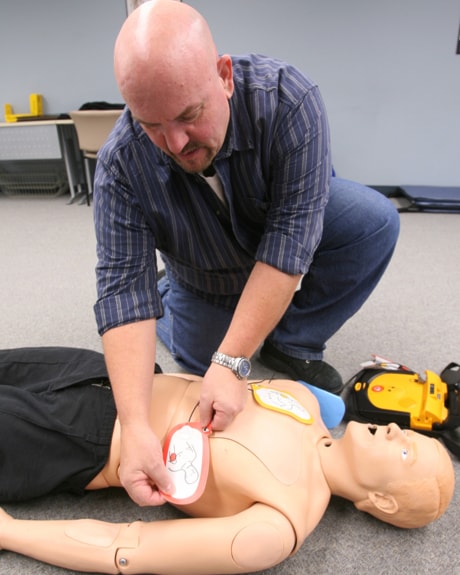Glenn Moskowy didn’t feel tightness in his chest, shortness of breath or numbness in his arms.
His atypical heart attack came out of the blue.
“All of a sudden, I felt dizzy. I remember looking up at the ceiling of the arena,” said Moskowy, who collapsed in cardiac arrest while playing hockey at Red Deer Arena more than two years ago.
“Then I woke up on the ice. I remember my teammates saying, ‘The paramedics are coming. They’re here. They’re here.’ ”
But help arrived even before Red Deer Emergency Services fire-medics were on the scene — an AED (automated external defibrillator) was installed at the city facility a year earlier and was ready for use.
“Without that machine, I would definitely be a dead guy,” said Moskowy. The Red Deer man was 48 at the time of his heart attack.
“The rink attendant saw the commotion and he brought the defibrillator to the boards,” said Moskowy, owner of Wallah Signs in Red Deer.
City staff were trained and AEDs installed at recreation sites in October 2007. So far, the only time a city AED has been used was for Moskowy on Sept. 21, 2008.
Moskowy, who had played for about 14 years on the Red Deer Wings old-timers hockey team, recalled playing hard that night.
His team had just moved the puck out of their zone and Moskowy was heading to the bench.
Teammate Jim Maundrell, of Red Deer, said all eyes were on the action in the offensive zone.
“All of a sudden I looked back and Glenn was laying on the ice. I wasn’t sure what happened. Nobody else saw either. We rushed over,” Maundrell said.
They checked Moskowy’s pulse and called for an ambulance. They started CPR (cardiopulmonary resuscitation) and artificial respiration.
Then the AED pads were attached to Moskowy’s chest and he responded after one shock.
“The doctors attributed the AED to Glenn’s recovery and minimizing the damage,” said Maundrell, a construction co-ordinator at Nova Chemicals, who was already trained to use AEDs at Nova, where the devices are also onsite.
“They are a valuable asset even though they’re not used as much as what everybody believes.”
The City of— or Red Deer has 21 AEDs at its facilities — seven at the Collicutt Centre, four at G.H. Dawe Community Centre, three at the Rec Centre, and one each at Michener Centre, Kinex Arena, Kinsmen Arena, Red Deer Arena, Great Chief Park, Lions Campground and Bower Ponds Pavilion.
Each AED costs about $1,900.
“We’re prepared. We needed it but it certainly isn’t something that happens frequently, which is a good thing,” said city recreation superintendent Kay Kenny.
The only other time a city AED was almost put to use, also at Red Deer Arena, was at last year’s Remembrance Day ceremony.
It turned out the person’s problem wasn’t a heart-related and the AED was not required.
Seventeen of the city’s AEDs at recreation sites are located where anyone can access them.
“They can be used by Joe Q. Public off the street. That’s the benefit of them and why we have them in our buildings on a wall that is accessible to the public. That’s the key.”
Kenny said if a building is staffed by one person, there is often no way that staff member can see someone in distress in another part of the building.
It’s important to boost the public’s awareness of AEDs, she said.
“It’s like fire exits. When you come into a building, they should be looking for where (AEDs) are and check it out.
“They are just on a wall and people go past them every day. You don’t think to look at it. After a while, you forget that they’re there.”
A variety of businesses and companies in Red Deer also have AEDs in case of emergency.
In 2007, Red Deer Firefighters Children’s Charity donated one AED each to Hunting Hills, Lindsay Thurber Comprehensive and Notre Dame high schools, where staff are trained to use them.
Hunting Hills and Lindsay Thurber students are also trained as part of health class.
Perry Tremblay, St. John Ambulance staff instructor in Red Deer, said when people are out in public, there’s a good chance someone close by has been trained on AEDs.
“They’re very easy to use. They talk to you and tell you what to do. There’s pictures on the pads to show you how they go on,” Tremblay said.
“The machine won’t let you shock someone who doesn’t need it. It won’t shock a normal heart rhythm.”
AED training is part of St. John Ambulance first-aid training.
Tremblay said even though it’s difficult to make a mistake with an AED, people should ideally have training to know, for example, that AED pads must stick so the skin needs to be dry and hair removed with the disposable razor provided if necessary, or that pads should not be put directly over an implanted pacemaker, or not to touch someone receiving the shock.
AEDs are to be used in conjunction with CPR.
Tremblay said the availability of AEDs in the community can help save lives while waiting for the ambulance.
“As a general rule, for every minute that goes by, you lose about a seven to 10 per cent chance of being successful in resetting the heart back to normal rhythm.”
szielinski@www.reddeeradvocate.com
